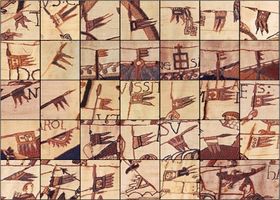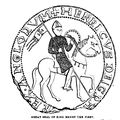Difference between revisions of "Banners"
m |
m (→References) |
||
| Line 140: | Line 140: | ||
<nocite> | <nocite> | ||
| + | BACKHOUSE1984 | ||
BACON1914 | BACON1914 | ||
GUMMERE1910 | GUMMERE1910 | ||
| Line 147: | Line 148: | ||
SWANTON1996 | SWANTON1996 | ||
TAYLOR1837 | TAYLOR1837 | ||
| − | |||
</nocite> | </nocite> | ||
<biblio force=false>#[[Template:Bib]]</biblio> | <biblio force=false>#[[Template:Bib]]</biblio> | ||
<HarvardReferences /> | <HarvardReferences /> | ||
Revision as of 15:35, 31 January 2015
| Banners |
|---|
|
More Weapons pages
Banners, standards, flags, gonfanon (guntfano) and pennons (pennants) were commonly adopted by the warriors of the 9th – 12th centuries. This article attempts to briefly outline what the authors currently know about the subject. The style of banner stays surprisingly consistent from the 9th to the 12th centuries and across Western Europe. For this reason we’ve decided to look at all the evidence together rather than, as we usually do, break the evidence into English, Carolingian, etc.
From Art
Pennons
These are triangular flags or streamers.
- Banner BL Cotton Caligula A XV f123r
c.1073AD English
BL Cotton Caligula A XV f123r
Banners
These are rectangular flags ending in ‘swallowtails’.
Before 1066AD
The Bayeux Tapestry
After 1066AD
From Literature
Bede – Ecclesiastical History of the English People, 731AD
- "His [King Edwin] dignity was so great throughout his dominions, that not only were his banners borne before him in battle, but even in time of peace, when he rode about his cities, townships, or provinces, with his thegns, the standard-bearer was always wont to go before him. Also, when he walked anywhere along the streets, that sort of banner which the Romans call Tufa, and the English, Thuuf, was in like manner borne before him." [SELLAR 1907]
- Osthryth, queen of the Mercians
- "...that there might be a perpetual memorial of the royal character of this holy man [King Oswald], they hung up over the monument his banner of gold and purple." [SELLAR 1907]
Capitulary of Charles the Bald, 843-877AD
- “Let our envoys (missi nostril) see that the troops of every bishop, abbot, and abbess, march forth properly equipped, and with their Gonfalonier (cum Guntfannonario).” [HEWITT 1885: p.166]
Beowulf, c.1000AD
- "High o'er his head they hoist the standard,
- a gold-wove banner; let billows take him,
- gave him to ocean." [GUMMERE 1910]
- "To Beowulf gave the bairn of Healfdene
- a gold-wove banner, guerdon of triumph,
- broidered battle-flag" [GUMMERE 1910]
- "His glance too fell on a gold-wove banner
- high o'er the hoard, of handiwork noblest,
- brilliantly broidered; so bright its gleam," [GUMMERE 1910]
The Song of Roland, 1040-115AD [BACON 1914] LEONABD BACON 1914
- Verse 4
- "And Geoffrey of Anjou, the bearer of the King's gonfalon" [BACON 1914]
- Verse 33
- "Through Cerdagne, and through the valleys and the mountains they marched on,
- Until of the French army they saw the gonfalon.
- Where aU the twelve companions with the French rear-guard
- King Marsile will not tarry till he have joined the fray" [BACON 1914]
- Verse 39
- "They held Valentian lances, and shield on shoulder wore.
- White and blue and vermilion were the gonfalons they bore." [BACON 1914]
- Verse 59
- "Then an embroidered banner he gave unto Grandoign
- To lead his men against the Franks that battle they might join.
- And therewithal was given to Grandoign the whole command." [BACON 1914]
- Verse 125
- "And onwards Geoffrey of Anjou bore the great Oriflame —
- Because it was Saint Peter's, it bore the Roman name." [BACON 1914]
- Note: Oriflame was the name of Charlemagne's banner
- Verse 137
- "Right through the Prince's body his golden banner bore.
- He smote him dead seven hundred of his servitors before." [BACON 1914]
- Verse 142
- "Ogier the Dane and Charlemagne well the great strokes laid on,
- And Neimes and Geoffrey of Anjou that bore the gonfalon.
- Ogier the Dane in all things a hero good was he.
- He spurred the steed beneath him, and let him gallop free.
- On him who bore the Dragon he let drive a buffet dread.
- Down to the earth before him he hurled Lord Amboire dead.
- And the banner of King Baligant in that hour came to ground.
- And Baligant beheld it fall, and the ensign of Mahound
- Without a man to guard it. In his heart he saw it plain
- How wickedness was on his side and the right with Charlemagne" [BACON 1914]
===William of Poitiers, The Deeds of William, Duke of Normandy and King of England (Gesta Willelmi ducis Normannorum et regis Anglorum) c.1071AD
===William of Malmesbury, Chronicle of the Kings of England (Gesta Regum Anglorum) c.1125AD
“The king himself on foot, stood with his brother, near the standard; in order that, while all shared equal danger, none might think of retreating. This standard William sent, after the victory, to the pope; it was sumptuously embroidered, with gold and precious stones, in the form of a man fighting.” [GILES 1847:p.276]
Master Wace, The Chronicle of the Norman Conquest (Roman de Rou), c.1174
- Line 11,450
- “When Harold had made all ready, and given his orders, he came into the midst of the English, and dismounted by the side of the standard, Leofwin and Gurth, his brothers, were with him; and around him he had barons enough, as he stood by his gonfanon, which was in truth a noble one, sparkling with gold and precious stones. After the victory William sent it to the apostle, to prove and commemorate his great conquest and glory.” [TAYLOR 1837]
- “L’apostoile li otreia, un gonfanon li enveia, un gonfanon et un anel, mult precios e riche e bel; si come it dit, desoz la pierre, aveit un des cheveuls Saint Pierre”[MICHEL 1836: p.147] Charlemagne: An Anglo-Norman Poem of the Twelfth Century edited by Francisque Michel 1836
Late Roman Draco Standards
Art
Literature
|
"Hic arripiens signum quod apud eo habebatur sacrum, leonis atque draconis desuper aquilae volantis insignitum effigie ..." |
|
About Witikind, an adversary of Charlemagne. [OAKSHOTT 1960:p178] |
Archaeology
--
Discussion
"... be the end would have been different. But Harold was struck, and cut down by a Norman sword when William's knights burst through the Huscarles to trample down the Dragon standard and Harold's banner of the Fighting Man." [OAKSHOTT 1960:p.180]
References
<nocite> BACKHOUSE1984 BACON1914 GUMMERE1910 HEWITT1885 OAKSHOTT1960 SELLAR1907 SWANTON1996 TAYLOR1837 </nocite> <biblio force=false>#Template:Bib</biblio>



